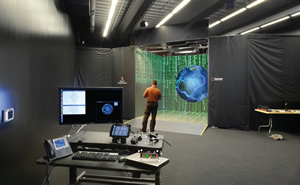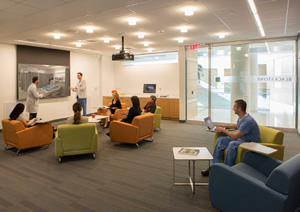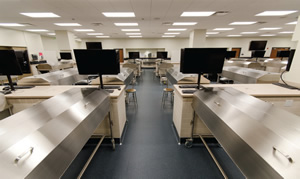Plugging In to STEM
Technology is taking center stage in STEM education, offering real-world training options and engaging today's tech-savvy students.

PHOTO © FRED J. FUHRMEISTER
Learning opportunities in science, technology, engineering and mathematics (STEM) are getting a big push today, and college campuses are incorporating new technologies to encourage and engage their students. A variety of components, experts have found, ensure that STEM students receive the best training and experience before embarking on their careers.
Technology Has Changed the Classroom
For the STEM student, a traditional learning environment is not enough to provide critical as well as creative thinking and assessment of skills while also enabling instructors with the proper methods to assess their students’ skills and development. Tablet computers, interactive software, smartphones and various immersive technologies are now integrated within the classroom setting.
At Missouri University of Science and Technology in Rolla, MO, Dr. Klaus Woelk, interim department chair and associate professor of chemistry, was instrumental in redesigning the university’s classrooms by introducing clicker technology approximately 10 years ago. The purpose of adding clickers was to engage students in activities instead of allowing them to sit passively in class. The clickers offered an immediate impact because students were required to answer questions. “Using clicker technology has stimulated discussion among our students,” Dr. Woelk says.
At times, students will tune in remotely to Dr. Woelk’s class online. A camera is set up at the podium in the classroom and a window appears on the computer screen so that students viewing the lecture online see the face of the instructor. “Facial expressions are important because they help to keep the students engaged,” Dr. Woelk says. A side camera has also been added so that students in the classroom can see the instructor but he has the freedom to walk around as he lectures. Along with the cameras, a tablet computer and stylus have replaced the traditional blackboard. The mobile device enables Dr. Woelk to write on the screen throughout the lecture. The information is easily seen as it is projected on a screen for the students who are in the classroom. For those who are watching the lecture online, the material is viewable from their own laptop, desktop or mobile device.

PHOTO COURTESY OF ARC/ARCHITECTURAL RESOURCES CAMBRIDGE, © PETER VANDERWARKER, PHOTOGRAPHER
LET’S GET REAL. At the Albert Sherman Center on the University of Massachusetts Medical School’s Worcester campus, students engage in hands-on learning at the interprofessional Center for Experiential Learning and Simulation, working with advanced clinical mannequins and actors trained to present like patients with specific conditions.
“I encourage students to form groups in class or online rather than to view the lecture by themselves online from their dorm or some other location,” Dr. Woelk adds. “The technologies we are using allow the students to answer clicker questions. They can collaborate with the other students in the class or online. Collaborating helps the group to learn.”
Unlike many professors who ban cell phones, Dr. Woelk’s take is the complete opposite. Instead, he encourages his students to text him during his lectures so that questions can be answered in real time. The professor’s laptop is equipped with Google Voice so that he can accept text messages from students. Pupils, both in the room and who are online, can text comments and questions during the lecture. Dr. Woelk says, “I have found that students who would never raise their hands in class now have a communication tool that they are excited to use and will go ahead and ask questions. With texting, the students always remain anonymous. No one knows who is asking a question or sending a comment.”
Student Learning Through Simulation
BSA LifeStructures, a full-service architectural and engineering firm, designed the learning and simulation spaces at the Michael A. Evans Center for Health Sciences at Marian University in Indianapolis. This 140,000-square-foot facility, which is home to the College of Osteopathic Medicine and School of Nursing, consists of patient simulation centers among lecture halls, labs (seen on page 58, bottom) and classrooms, offering an immersive experience for students. “Rooms are set up to simulate medical situations through the use of interactive mannequins within a healthcare environment. The setting is controlled and monitored so that students can apply their skills in a lifelike medical environment for hands on learning,” says Geoffrey Lisle, architect and principal at BSA LifeStructures.
These immersive technology centers encourage students to utilize their knowledge and training in medical situations, such as caring for a heart attack patient, through the use of a simulated mannequin in a risk-free environment that is realistic, challenging and intense. These scenario rooms also utilize audio and video recordings for later playback, giving students the opportunity to evaluate how well they performed during the simulation.
The medical experience becomes more inspiring and memorable than a lesson in a classroom. It also prepares students for a career in the sciences. Lisle says, “STEM education, in terms of technology trends, is moving from lecture-based lessons to immersive curriculum that allows students to work in teams to tackle challenges. It has evolved from single source learning to multidisciplinary and project-based.”
The Three-Dimensional Experience
The recently opened Energy Innovation Center (EIC) at the University of Wyoming (UW) positions the university as a global leader in energy education, research and outreach and a core recruiting institution by international energy companies.
Designed by HOK and GSG Architecture for the UW School of Energy Resources (SER), Enhanced Oil Recovery Institute (EORI) and its nine centers of excellence, the research and collaboration facility is focusing on such critical issues as enhanced oil recovery, carbon management and advanced coal technology.
“The EIC is one of the most advanced research facilities at the university,” says SER Director Mark Northam. “It will provide students, researchers and academic professionals the opportunity to actively engage in, observe and support advancements in sustainable energy technologies.”

PHOTO COURTESY OF SCHMIDT ASSOCIATES
The EIC contains 12,000 square feet of highly technical and reconfigurable research lab space and six technical and specialty labs including:
- A three-walled, 3D visualization research lab linked via 10-gigabit lines to one of the largest supercomputing centers in the world — the Wyoming National Center for Atmospheric Research Supercomputing Center (NWSC) in Cheyenne;
- the world’s most advanced reservoir characterization lab dedicated to the study of fluid flow in unconventional reservoir rocks; and
- a 1,296-square-foot drilling simulator for teaching students to explore, test and interact with an extensive array of drilling rig components.
The 3D visualization lab (seen on page 54) is notable in its ability to create a model of the subsurface of the earth that will help energy companies pinpoint where they can extract minerals most efficiently. Equipment with three different levels of display power will enable a range of resolutions and functions for visualizing complex data sets. “Rather than viewing a 3D screen, the center resembles a cavern with three vertical walls and a floor that makes researchers feel as if they are physically immersed in the image,” Northam says.
The Classroom’s Changing Dynamic
In addition to the new technologies that colleges are integrating, the overall environment of the STEM classroom has changed. Francis Cauffman, a national architecture firm with offices in New York City, Philadelphia and Washington, DC, was instrumental in designing Institute Hall, a 78,000-square-foot research facility for chemical and biomedical engineering at the Rochester Institute of Technology (RIT).
Steven Stainbrook, AICP, director of higher education at Francis Cauffman, says, “RIT’s new building accommodates forward-looking instructional models like the ‘flipped classroom.’ In this flexible learning environment, traditional homework and classwork are reversed. Instead of sitting in regimented rows of desks and waving their hands in the air before speaking, students move into flexible spaces within the classroom for project-centered group work ‘coached’ by their instructor.”
He adds, “Students listen to lectures at home, using a streaming video. In class, they discuss the content of the lecture with each other, taking an active role in their education. The professor facilitates the discussion and orchestrates small breakout groups. This model maximizes student engagement, providing the opportunity to learn from peers as well as the instructor.”
Having options is most effective. “As architects, we have found that we need to provide a variety of space options, including classroom size, layout, furniture and technology to support every student behavior,” Kalevi Huotilainen, architect and principal at BSA LifeStructures notes.
Realistic and Memorable
Technology continues to improve the evolution of the classroom to state-of-the-art facilities filled with the latest tools that truly immerse students into STEM lessons. These offerings not only encourage students to engage in thought-provoking tasks, but also to challenge their skillsets in environments that are realistic and memorable. And isn’t that what a college education is all about?
This article originally appeared in the issue of .